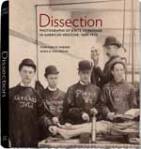I found this article interesting as it is local in flavor and surrounding what some might think is a morbid topic. I disagree, and can see why dissection of a cadaver would be a central experience in the education of medical student. When I was in high school, I interned at the Cuyahoga County Morgue and observed an autopsy. There I learned that Quincy (yeah, I’m that old and way before CSI) was not really how it worked. I became an attorney, of course.
 CWRU’s Allen Memorial is putting on an exhibition of photos from a century or more ago showing medical students with their cadavers. Many of the exhibits and photos are from the recently published book, Dissection, Photographs of a Rite of Passage in American Medicine 1880-1930 by James Edmonson from Case Western Reserve University and John Harley Warner from Yale University. As is discussed in the link to the photo below, during this era there was limited access to cadavers for anatomical teaching. So, learning, for many students, required a bit of self help. We’ll leave it at that. The link on the photo at left has some of these photos.
CWRU’s Allen Memorial is putting on an exhibition of photos from a century or more ago showing medical students with their cadavers. Many of the exhibits and photos are from the recently published book, Dissection, Photographs of a Rite of Passage in American Medicine 1880-1930 by James Edmonson from Case Western Reserve University and John Harley Warner from Yale University. As is discussed in the link to the photo below, during this era there was limited access to cadavers for anatomical teaching. So, learning, for many students, required a bit of self help. We’ll leave it at that. The link on the photo at left has some of these photos.
I find the photos fascinating. Here we are, seeing photos of these student in the prime of their life exhibiting their anatomical subjects, that they treat well, humorously or in poor taste, but that all recently lost of the spark of life. And these students, too, are now long, long since passed. From the Plain Dealer article:
Long before “Tales from the Crypt ” “The Twilight Zone” and horror author Stephen King there were medical students. Students who at the turn of the 19th-to-the-20th century posed for photos with bodies they had dissected in their studies; who gathered in groups around flesh-peeled cadavers and skulls like hunters displaying trophies…Dissection portraiture had its heyday from 1880 to 1930…The photos were a visual representation of a rite of passage dissection to a new identity a “boundary-crossing experience that left the participant forever changed ” as Warner wrote in the book…Back then there was no legal means of obtaining bodies for dissection. Some were unclaimed bodies but many were provided by grave-robbers known as “professional resurrectionists.” … Warner described most of the photos as almost “reverential” in the treatment of the subject some bearing such phrases written on the dissection tables as “Know Thyself ” “Man s usefulness endeth not with death” and “Her loss is our gain.” But he noted that others the gag photos and macabre images almost seem to revel in the transgression — posing human remains in outlandish poses or providing such accompanying table-epigraphs as “Such the vultures love ” “Rest in pieces” and “The Lord giveth We taketh away.”
Filed under: Bioethics, Health Law, Personal Posts, CWRU, Health, Philosophy, Public Health, UH
[…] Original post by ptkostyack […]